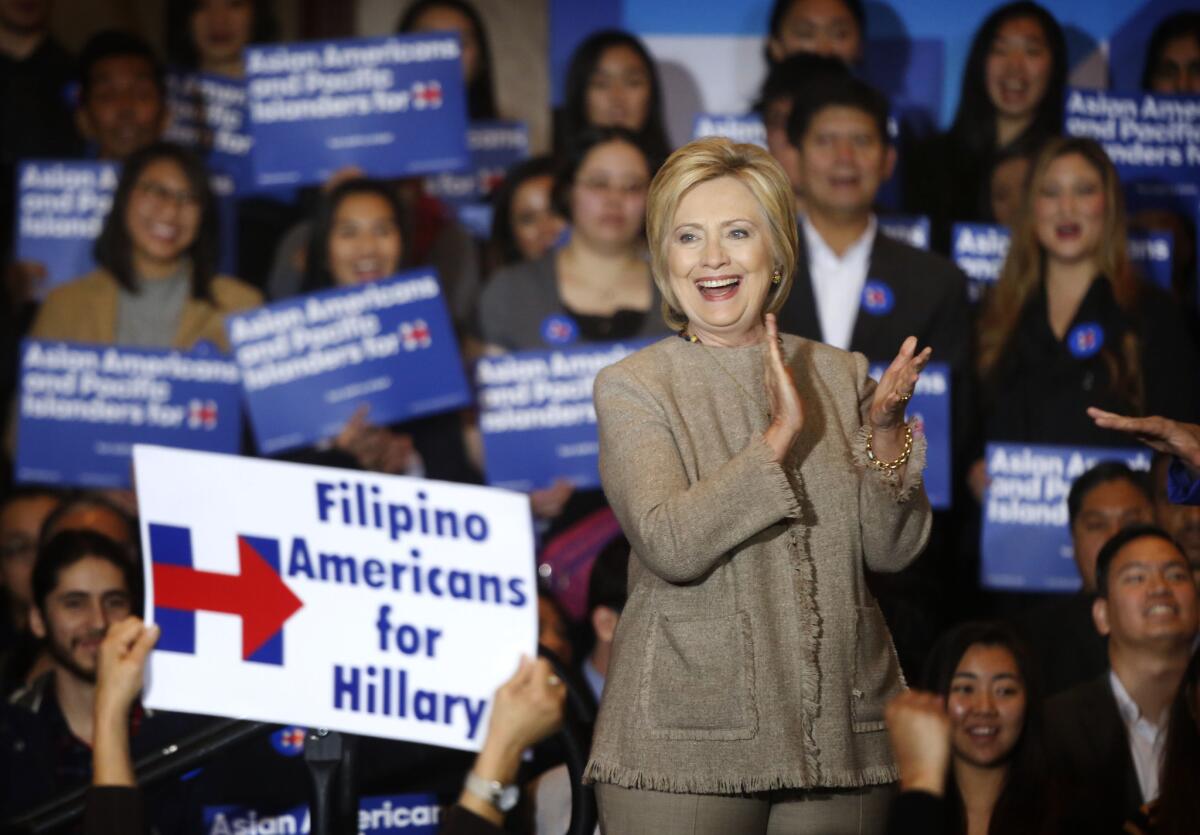Asian American voters are spurning Trump — and threatening to spurn the Republican Party

- Share via
For years, Republicans have expressed angst at their poor showing among Latino voters. But the focus on that group has obscured another, related problem for the party: antipathy on the part of what has become the fastest-growing ethnic group in the country, Asian Americans.
And there’s new proof that the tactics and policy positions that have alienated Latinos are now having a dire effect for Republicans on Asian voters as well.
Asian American voters are siding strongly with Hillary Clinton in the presidential contest, as younger voters in particular abandon Donald Trump and the Republican Party, a new poll of those voters has found.
Clinton has a firm hold on 55% of Asian American voters. When those leaning toward the candidates are counted, she leads Trump by 49 points, 70% to 21%.
That puts her in striking distance of President Obama’s standing in the 2012 election, when he won 73% of Asian American voters, according to exit polls.
Election 2016 | Live coverage on Trail Guide | Sign up for the newsletter | The race to 270
The results released Wednesday as part of the National Asian American Survey suggest that Trump’s rhetoric — especially on immigration — has caused an irreparable breach with those voters.
“All of the anti-immigrant rhetoric and harsh tone and language is a turnoff to voters,” said Karthick Ramakrishnan, a UC Riverside political science professor and associate dean of the School of Public Policy, who directed the survey.
In a twist, the gender and education demarcations seen in the national electorate this year were absent among Asian Americans: A majority of both men and women sided with the Democratic nominee, as did almost 6 in 10 of both college-educated voters and those without college degrees.
Among white voters, Trump has regularly claimed the allegiance of men and those without college degrees; Clinton has won among women and the college-educated.
The findings among Asian American voters are similar to results in surveys this year among Latino voters, who have sided with Clinton regardless of gender or educational experience.
“Race seems to trump the impact of other categories like gender and class,” Ramakrishnan said. “This is fairly clear evidence that we do not live in a post-racial society.… Other differences like education don’t matter as much for communities of color.”
As negative as Asian American voters overall were toward the Republican nominee and his party, the views worsened among younger voters, suggesting a difficult path ahead regardless of the results of November’s election.
Fifty-two percent of voters in the poll overall had a “very unfavorable” view of Trump; among millennial voters that figure rose to 69%. Adding in voters with a “somewhat unfavorable” position resulted in 67% with a negative view of him. Among voters under age 35, that rose to 81%.
Clinton, by contrast, was seen in a “very unfavorable” light by only 18% of voters; 36% were either somewhat or very negative toward her. Almost 6 in 10 voters thought well of Clinton, compared with only 23% for Trump.
But it was voters’ views of Republicans that spelled the greatest long-term danger to a party whose base of older white voters is rapidly losing strength in the electorate. (Asian American voters will make up 3% to 4% of November voters nationally, but their heft will be felt more acutely in contested states like Nevada and Virginia.)
Almost 6 in 10 Asian American voters had a negative view of the Republican Party; fewer than 3 in 10 had a positive view. Those numbers were reversed when it came to the Democratic Party.
And, as with Trump, younger voters were more negatively disposed. Seven in 10 of voters under age 35 had an unfavorable view of the GOP, compared with 31% who had a negative view of the Democratic Party.
That alliance with Democrats — and against the Republicans — is telling because Asian American voters have historically been more independent than other groups.
About 4 in 10 said in the new survey that they were independent, and another 4 in 10 said they were Democrats. Only 16% said they were Republicans.
But when independents who lean toward a particular party were considered, almost 6 in 10 were with the Democrats. Among younger voters, that figure rose to 7 in 10.
The liberal alliance appeared to be driven by issues. The survey found strong support among Asian American voters for President Obama’s healthcare plan, for government help with college costs and for measures that would limit emissions in order to lessen climate change.
Trump’s proposal to ban Muslims from entering the country was opposed by almost two-thirds of Asian American voters. But they were more equivocal about accepting Syrian refugees, with 44% approving and 35% opposed.
The exception when it came to embracing liberal views was the legalization of marijuana: 56% were opposed and only 36% were in support.
The survey illuminated a quirk found in almost all polling of Latino or Asian voters: Immigration is a powerful character test for candidates, but it doesn’t rank high on the list of issues that those voters think are most pressing.
In the Asian American survey, the economy was seen as the most important issue, followed distantly by terrorism and racism. Immigration was cited as the most important issue by only 4% of voters — less than one-sixth the percentage who cited the economy.
But immigration clearly is a threshold issue, Ramakrishnan said — one that can either block a candidate from consideration or ease the path to acceptance, depending on their position and tone. In Trump’s case, his handling of the issue has blunted his candidacy.
“The way that a candidate talks about immigration is a sign of respect or disrespect,” Ramakrishnan said. “It’s not that immigration is a big policy issue — it’s that they can’t bring themselves to vote for someone who seems to disrespect their community.”
The poll questioned 2,238 Asian American adults, including 1,694 registered voters, between Aug. 10 and Oct. 1. It has a margin of error of 3.5 points in either direction among registered voters, and larger for other subgroups.
Twitter: @cathleendecker
ALSO:
Pennsylvania: once merely important, now Hillary Clinton’s firewall
Tax troubles threaten Trump as election day nears. So does his approach to campaigning
Live coverage from the campaign trail
More to Read
Get the L.A. Times Politics newsletter
Deeply reported insights into legislation, politics and policy from Sacramento, Washington and beyond. In your inbox three times per week.
You may occasionally receive promotional content from the Los Angeles Times.











